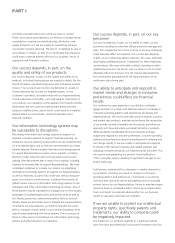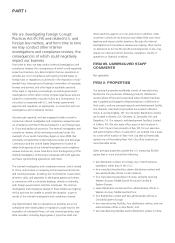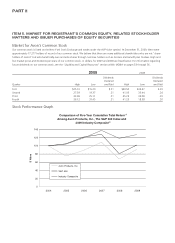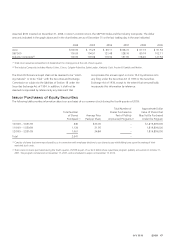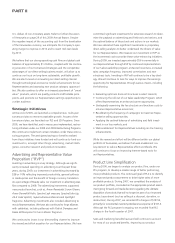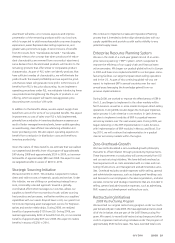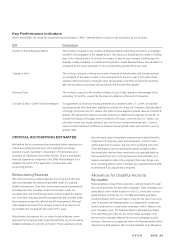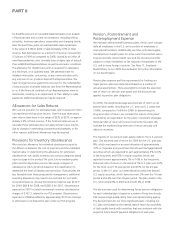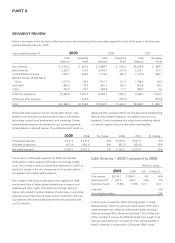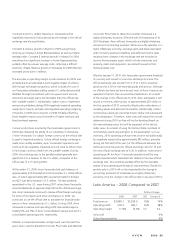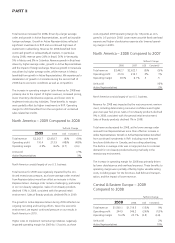Avon 2009 Annual Report Download - page 39
Download and view the complete annual report
Please find page 39 of the 2009 Avon annual report below. You can navigate through the pages in the report by either clicking on the pages listed below, or by using the keyword search tool below to find specific information within the annual report.assortment will allow us to increase exposure and improve
presentation of the remaining products within our brochure,
which is expected to yield more pleasurable consumer shopping
experiences, easier Representative selling experiences, and
greater sales per brochure page. A second source of benefits
from PLS results from “transferable demand.” Transferable
demand refers to the concept that when products with redun-
dant characteristics are removed from our product assortment,
some demand from the eliminated products will transfer to the
remaining products that offer similar or comparable product
characteristics. As part of PLS, when we identify products that
have sufficient overlap of characteristics, we will eliminate the
products with the lowest profitability and we expect the prod-
ucts that we retain will generate more profit. A third source of
benefits from PLS is less price discounting. As we implement
operating procedures under PLS, we anticipate introducing fewer
new products and lengthening the lifecycle of products in our
offering, which we expect will lead to less aggressive price
discounting over a product’s life cycle.
In addition to the benefits above, we also expect supply chain
benefits to account for some of our projected benefits. We expect
improvements to cost of sales once PLS is fully implemented,
primarily from a reduction in inventory obsolescence expense as a
result of better managed inventory levels, lower variable spending
on warehousing, more efficient manufacturing utilization and
lower purchasing costs. We also expect operating expenses to
benefit from a reduction in distribution costs and benefits to
inventory productivity.
Given the nature of these benefits, we estimate that we realized
our targeted total benefits from this program of approximately
$40 during 2008 and approximately $120 in 2009, or incremen-
tal benefits of approximately $80 over 2008. We expect to real-
ize targeted benefits in excess of $200 in 2010.
Strategic Sourcing Initiative
We launched SSI in 2007. This initiative is expected to reduce
direct and indirect costs of materials, goods and services. Under
this initiative, we are shifting our purchasing strategy from a
local, commodity-oriented approach towards a globally-
coordinated effort which leverages our volumes, allows our
suppliers to benefit from economies of scale, utilizes sourcing
best practices and processes, and better matches our suppliers’
capabilities with our needs. Beyond lower costs, our goals from
SSI include improving asset management, service for
tatives and vendor relationships. During 2008, werealized
benefits of approximately $135 from SSI. During 2009,we
realized approximately $200 of benefits from SSI, orincremental
benefits of approximately $65 over 2008. We expecttorealize
benefits in excess of $250 in 2010.
We continue to implement aSales and Operations Planning
process that is intended to better align demand plans with our
supply capabilities and provide us with earlier visibility to any
potential supply issues.
Enterprise Resource Planning System
We are in the midst of amulti-year global roll-out of an enter-
prise resource planning (“ERP”) system, which is expected to
improve the efficiency of our supply chain and financial trans-
action processes. We began our gradual global roll-out in Europe
in 2005 and have since implemented ERP in our European manu-
facturing facilities, our larger European direct-sellingoperations
and in the U.S. As part of this continuing global roll-out, we
expect to implement ERP in several countries over the next
several years leveraging the knowledge gained from our
previous implementations.
During 2008, we worked to improve the effectiveness of ERP in
the U.S. and began to implement in the other markets within
North America, as well as in some smaller European direct-selling
operations. During 2008, we also began themulti-year implemen-
tation process in Latin America in one market. In Latin America,
we plan to implement modules of ERP in agradual manner
across key markets over the next several years. During 2009, we
began delivering on the ERP implementation in Latin America,
with implementation of ERP modules in Mexico and Brazil. Dur-
ing 2010, we will continue the implementation in agradual
manner across key markets within the region.
Zero-Overhead-Growth
We have institutionalized azero-overhead-growth philosophy
that aims to offset inflation through productivity improvements.
These improvements in productivity will come primarily from SSI
and our restructuring initiatives. We have defined overhead as
fixed expenses such as costs associated with our sales and mar-
keting infrastructure, and management and administrative activ-
ities. Overhead excludes variable expenses within selling, general
and administrative expenses, such as shipping and handling costs
and bonuses to our employees in the sales organization, and also
excludes consumer and strategic investments that are included in
selling, general and administrative expenses, such as advertising,
RVP, research and development and brochure costs.
Restructuring Initiatives
2005 Restructuring Program
We launched our original restructuring program under our multi-
year turnaround plan in late 2005. We have approved and announced
all of the initiatives that are part of the 2005 Restructuring Pro-
gram. We expect to record total restructuring charges and other
costs to implement restructuring initiatives under this program of
approximately $530 before taxes. We have recorded total costs
AVON2009 21
Represen-



